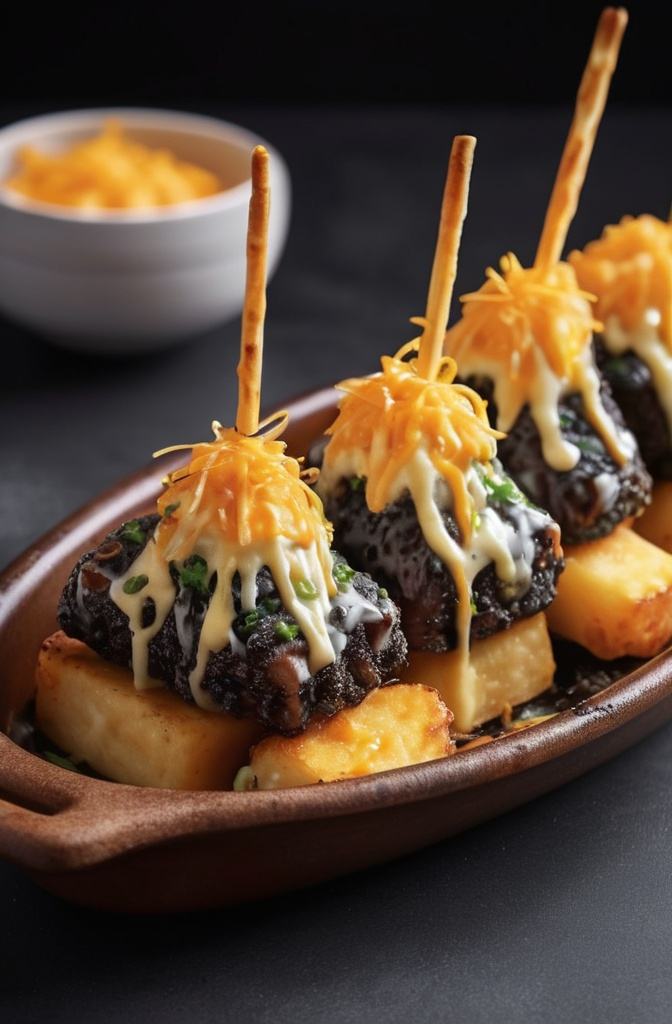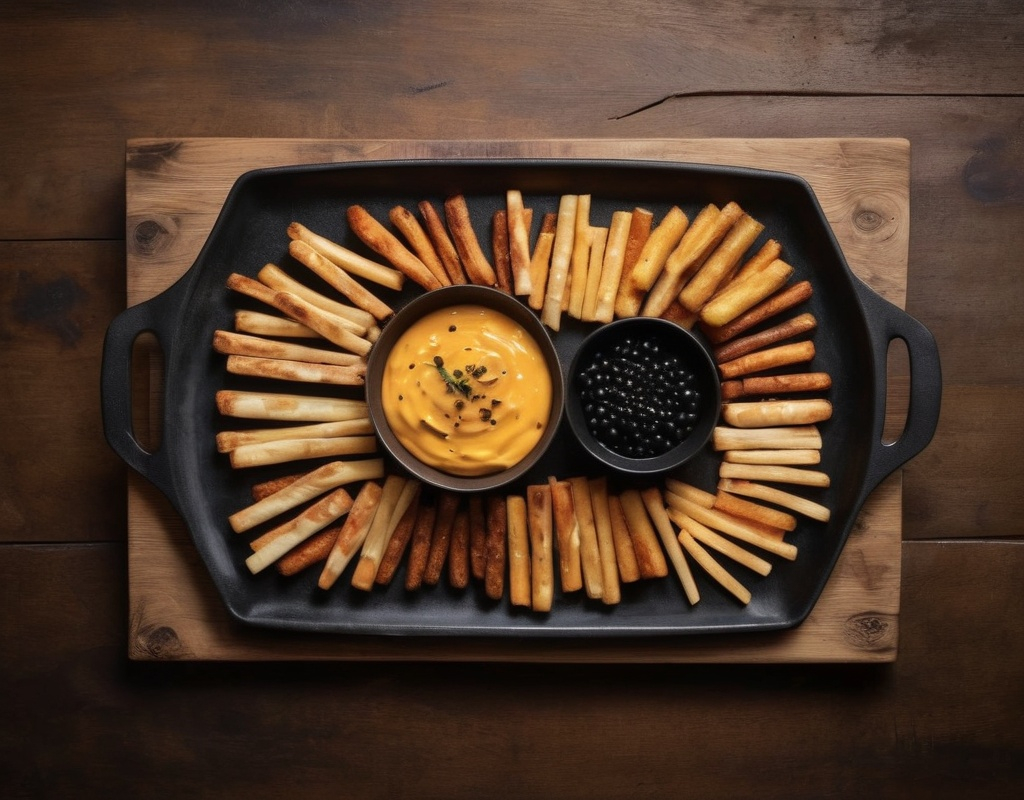Let’s be real, some dishes just get under your skin—in a good way. They sneak into menus across bars, diners, food trucks, high-end gastropubs, and even into your midnight kitchen cravings. One of those sneaky culinary charmers? Loaded potato and cheese sticks. They’re crispy, cheesy, often outrageously indulgent, and if done right—downright addictive. But behind the golden crust and molten cheese lies a world of technique, ingredient chemistry, and cultural evolution. This ain’t just snack food. It’s serious business.
This article dives deep into the real-deal craft of making loaded potato and cheese sticks. Not just for the casual cook tossing frozen snacks in an air fryer—but for culinary professionals, restaurateurs, and food innovators who want to nail that perfect bite or even elevate it to something… unforgettable.
What Exactly Are We Talking About?
Loaded potato and cheese sticks sit somewhere between a croquette and mozzarella sticks. Think of a hybrid. It starts with mashed or grated potatoes, typically mixed with cheeses—mozzarella, cheddar, Monterey Jack, or a blend. Then come the “loaded” elements: think bacon, scallions, jalapeños, caramelized onions, maybe even brisket. The mix is shaped into logs, breaded, then deep-fried (or baked, if you’re pretending to behave).
But these aren’t your average frozen aisle filler. When crafted right, they balance textures and flavors so well, you could put them on a tasting menu next to a seared duck breast and no one would blink.
A Brief History—and Why It Matters
You won’t find a culinary textbook on the history of loaded potato and cheese sticks. No one’s tracing them to an ancient Roman cheese vendor. They’re newish. But they’re part of a broader lineage—one that includes croquettes (from 18th-century France), jalapeño poppers (American Southwest, 1970s), and mozzarella sticks (New Jersey diners, 1980s). What they all share is that golden-fried appeal and a need for technical finesse underneath the indulgence.
In professional kitchens, knowing where a dish sits on the culinary spectrum helps in adapting it for your market. High-volume sports bars? Go heavy on bacon and cheddar. Upscale street food pop-up? Truffle mash and fontina cheese might be your ticket.
The Potato: Base, Binder, Backbone
Start with the wrong kind of potato, and you’re sunk before you even hit the fryer. Russets are your safest bet—they’ve got a high starch content, low moisture, and mash like a dream. Yukon Golds? Nice flavor but a bit waxy. Avoid red potatoes; they don’t mash well and can make the interior gummy.
Always, and I mean always, dry your potatoes properly. Moisture is your enemy in frying. One pro trick: after boiling and mashing, spread the mash on a sheet tray and let it cool and dry in the fridge for at least an hour. Overnight is even better.
And let’s be clear here: instant mashed potatoes are a hard no. The texture’s off, and they bring this weird artificial aftertaste. You can taste the shortcut. Every time.

Cheese Choice: Pull, Stretch, or Punch?
Cheese in this context does three jobs: texture (stretch), flavor (sharpness), and mouthfeel (creaminess). Mozzarella gives that stretchy, satisfying pull everyone wants. Cheddar brings sharpness. Monterey Jack melts smooth and has a mellow tone.
A combo often works best. A 50/30/20 blend of mozz, sharp cheddar, and Monterey Jack hits that trifecta. Want more umami depth? Add a smidge of aged gouda or even blue cheese for funk.
But be careful with meltability. Hard cheeses like Parmesan don’t do well here—they’ll clump. And American cheese? It melts like a dream, sure, but it can taste plasticky when overcooked.
The “Loaded” Factor: Go Big or Go Balanced
This is where artistry comes in. The extras you mix in—the “loaded” part—have to play well together. Salted and crispy bacon? A no-brainer. Jalapeños? Bring heat but also a fresh green snap. Scallions or chives? Needed for brightness.
But resist overstuffing. Too many ingredients and you lose cohesion. Also, wet ingredients (like cooked mushrooms or caramelized onions) should be chopped super fine and well-drained. You don’t want soggy centers.
Smoked meats like brisket or pulled pork can work beautifully—if you keep them in small amounts. Think flavoring agent, not filler. This isn’t a burrito.
Binding It All Together
If your mix doesn’t hold its shape, you’re looking at a fryer disaster. You need a binder. A classic combo: one egg yolk per 2 cups of potato mix, plus 1–2 tablespoons of flour or cornstarch. Too much flour and you end up with a doughy center. Too little and it falls apart.
Some chefs prefer using potato starch instead of flour—it preserves that clean potato flavor and gives a smoother bite. And here’s a neat trick: a pinch of baking powder can give the crust a puffier texture during frying.
Shaping and Breading: It’s Not Just a Coating, It’s Armor
Shape matters. Logs or batons work best—they cook evenly and fit into fry baskets or sheet pans neatly. Balls are a no-go; the centers stay cold while the outsides overbrown.
For the coating: go with the triple threat. Flour, then egg wash, then panko breadcrumbs. Panko gives you that crispy crunch people hear from across the table.
Want that extra golden finish? Add a teaspoon of paprika and garlic powder into the flour mix. It doesn’t just season—it caramelizes during frying.
Pro tip: chill the shaped sticks for at least an hour before frying. Freezing for 10–15 minutes before breading helps too. You’re building a culinary bunker here.

Frying: This Is Where It Lives or Dies
Temperature is life. Oil between 350–375°F (175–190°C). Too cold and the sticks absorb oil like a sponge. Too hot and the crust burns before the cheese melts.
Use neutral oils—canola, peanut, sunflower. Don’t go fancy with olive oil here. And never crowd the fryer. You’ll crash the temp and end up with soggy sadness.
Timing? About 2–3 minutes. You’re not cooking raw ingredients—just heating and crisping. As soon as the crust is golden and you see a bit of cheese escape, you’re good.
Baking or Air-Frying: For the Lighter Side of Decadence
Alright, we’ve all got health-conscious customers or vegan Instagram influencers to please. Baking can work—just make sure to spritz the sticks with oil before they go into a 425°F (218°C) oven. Flip once. Bake for 20–25 minutes.
Air-frying is trickier. The crust gets dry without proper oil coating, and cheese melt can be inconsistent. But it can be done. Freeze the sticks solid first and preheat the air fryer. Cook in batches. Expect about 10–12 minutes per batch.
Dips: The Unsung Heroes
You can’t serve these naked—not in spirit anyway. Dips are the closing argument.
Ranch? Classic. Buttermilk-based is best, with cracked pepper and a hit of dill. Chipotle aioli adds smoky heat. Sour cream + chive is mellow but classy. And don’t sleep on beer cheese sauce—made with sharp cheddar, beer (lager or ale), and mustard.
Or go wild. Kimchi mayo, black garlic ranch, blue cheese and hot honey… if the stick is the body, the dip is the soul.
Costing, Storage, and Scalability: The Business Side
From a commercial kitchen standpoint, these sticks are gold. Cost per unit is low—potatoes and cheese are cheap in bulk. Labor is moderate but manageable with batch prep.
They freeze well, breaded and uncooked. Just layer between parchment and store in airtight containers. Use within 30 days. Fry from frozen—just add an extra minute.
Shelf life post-fry? Not long. Serve within 10 minutes or quality drops fast. Limp fries can be forgiven. Limp cheese sticks? Never.
Common Mistakes That’ll Kill Your Batch
- Undercooked centers due to oversized sticks or cold oil.
- Overstuffing with wet ingredients.
- Using the wrong cheese—melts too much or too little.
- Skipping the chill before frying—your crust will slide off.
- Overfrying. This ain’t fried chicken. Two minutes, done.
Trends: Where Are Loaded Potato and Cheese Sticks Going Next?
In 2025, this humble dish is getting weird. And we love it.
Korean-inspired versions with gochujang and kimchi are hot (literally). Vegan versions using cashew cheese and sweet potato are hitting boutique menus. And truffle-loaded varieties are popping up in hotel bars.
There’s also a growing love for global mashups—think tikka masala potato sticks or cheddar-jalapeño arepas.
And data backs the trend: According to Technomic’s 2024 Snacking Report, over 62% of U.S. consumers said they’re more likely to order an appetizer if it has a crispy-cheesy component. That’s not just a stat. That’s your business strategy.
Wrapping It Up: Make It Matter
Loaded potato and cheese sticks may look simple, but they’re a showcase of smart culinary engineering. Every step—from the mash to the melt to the crunch—has to be dialed in.
For chefs, this dish can be a brand signature. For operators, it’s a low-cost, high-margin menu star. And for customers? It’s comfort, craft, and just a bit of chaos on a plate.
So go ahead. Load it up, fry it crisp, serve it hot. And when someone takes that first bite and makes that mmm noise? That’s the sound of technique well executed.
FAQs
What type of potato is best for loaded potato and cheese sticks?
Russet potatoes—they’re starchy, dry, and hold structure perfectly after mashing.
Can I use instant mashed potatoes for this recipe?
Nope, they taste artificial and ruin the texture completely.
What cheese blend works best?
A mix of mozzarella, sharp cheddar, and Monterey Jack gives you stretch, flavor, and melt.
How do I stop the sticks from falling apart while frying?
Use egg and a bit of flour or cornstarch to bind the mix, and chill them before frying.
What’s the ideal frying temperature?
Keep your oil between 350–375°F (175–190°C) for crispy crusts and melty centers.
Can these be baked instead of fried?
Yes, bake at 425°F with a light oil spray, flipping once for even browning.
Do they freeze well before cooking?
Absolutely—layer with parchment and freeze for up to a month, then fry straight from frozen.
How long should I fry them?
Only 2–3 minutes, just until golden and the cheese starts to ooze.
What are common mistakes to avoid?
Too much moisture, wrong cheese, no chilling, or overcrowding the fryer—don’t do those.
What kind of dips pair best with these sticks?
Ranch, chipotle mayo, sour cream & chive, or beer cheese—they all slap.
Are there vegan versions of this recipe?
Yes, use mashed sweet potatoes and vegan cheese—just adjust for moisture.
Can I use different fillings in the mix?
Sure, but keep them dry and minimal—think bacon bits, chives, or brisket in moderation.
What makes them “loaded”?
It’s all the extras: bacon, cheese, herbs, jalapeños—stuff that adds flavor and heft.
How long can I hold them after frying?
Not long—serve within 10 minutes or the quality nosedives fast.
Are these profitable for food businesses?
Yes, high-margin, low-cost, and wildly popular—perfect for volume menus.

Mariana is a passionate home cook who creates delicious, easy-to-follow recipes for busy people. From energizing breakfasts to satisfying dinners and indulgent desserts, her dishes are designed to fuel both your body and hustle.
When she’s not in the kitchen, she’s exploring new flavors and dreaming up her next recipe to share with the Foodie Hustle community.

